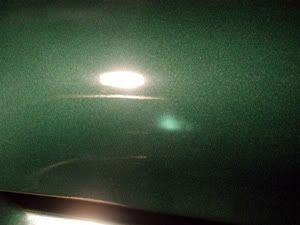Disclaimer: I'm new to machine polishing and still learning.
So I'm happily polishing away on my MINI Cooper with my PC, orange Sonus DAS pad and Z-PC. Suddenly I start seeing little bits of orange foam fly. I immediately turn off the PC and look at the pad.
The velcro backing is peeling away from the foam and the back of the pad is HOTTT.
Environment: I was alternating between speeds 3.5 to spread the Z-PC and 5.5-6 to polish out the microscratches. When I first started I sprayed one light shot of Z6 on the pad and then put on an X of Z-PC across the pad. I reloaded the Z-PC as needed (when it cleared/dried/started dusting). I got the bonnet (hood) and 1/4 of the roof done before the pad self-destructed, and I noticed that the PC seemed to be laboring a bit before the pad came apart. I finished the roof with a Sonus green pad and had no other problems.
Any thoughts or hints on what I was probably doing wrong to cause this?
FWIW, the velcro is separated about a quarter of the way around the foam and there is apparently no glue in the center of the pad from what I can tell. Can this be fixed with shoe-goo or should I just chalk it up to learning and replace the pad?
So I'm happily polishing away on my MINI Cooper with my PC, orange Sonus DAS pad and Z-PC. Suddenly I start seeing little bits of orange foam fly. I immediately turn off the PC and look at the pad.
The velcro backing is peeling away from the foam and the back of the pad is HOTTT.
Environment: I was alternating between speeds 3.5 to spread the Z-PC and 5.5-6 to polish out the microscratches. When I first started I sprayed one light shot of Z6 on the pad and then put on an X of Z-PC across the pad. I reloaded the Z-PC as needed (when it cleared/dried/started dusting). I got the bonnet (hood) and 1/4 of the roof done before the pad self-destructed, and I noticed that the PC seemed to be laboring a bit before the pad came apart. I finished the roof with a Sonus green pad and had no other problems.
Any thoughts or hints on what I was probably doing wrong to cause this?
FWIW, the velcro is separated about a quarter of the way around the foam and there is apparently no glue in the center of the pad from what I can tell. Can this be fixed with shoe-goo or should I just chalk it up to learning and replace the pad?




